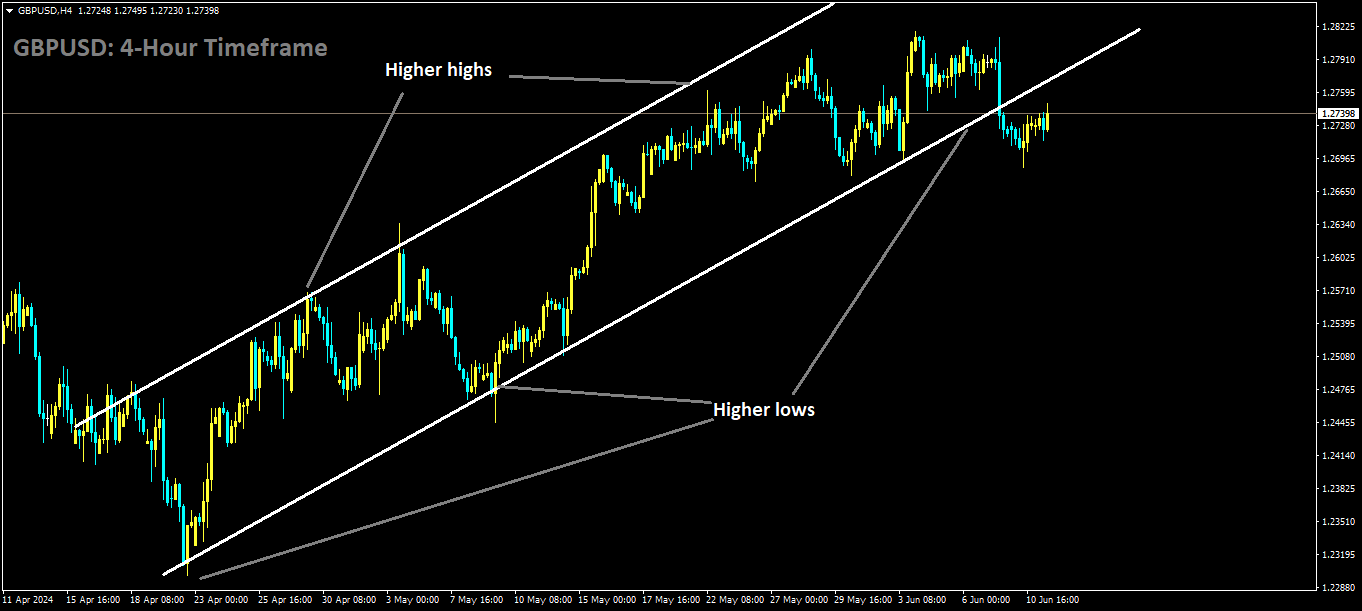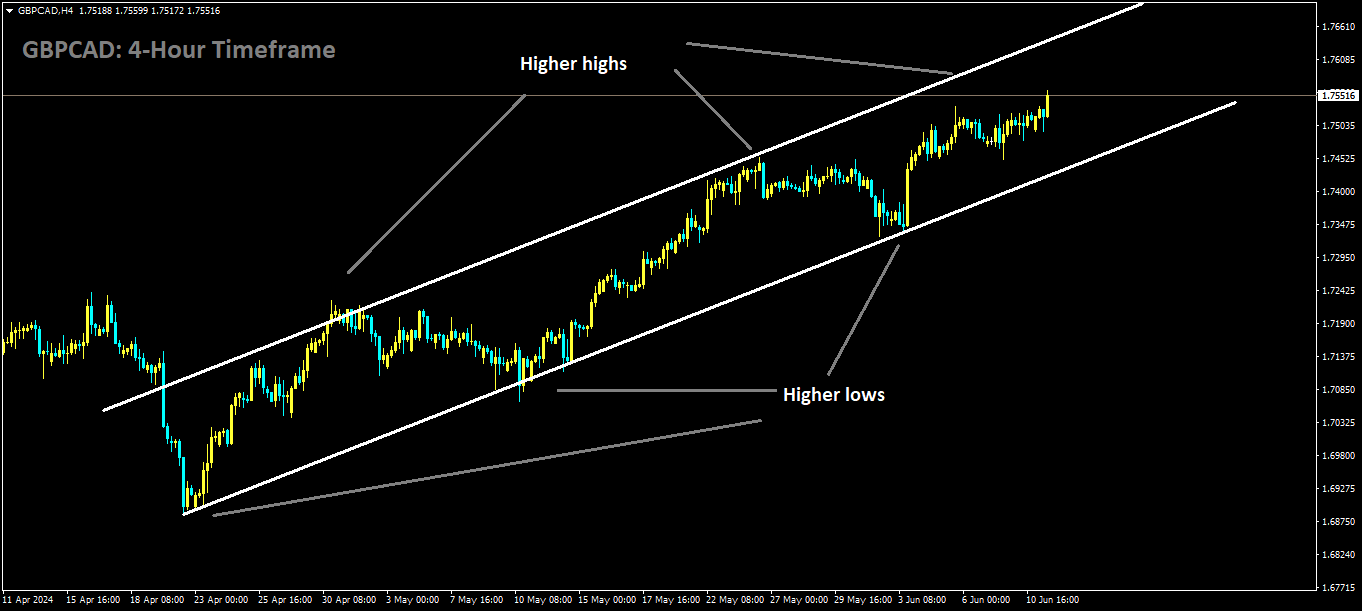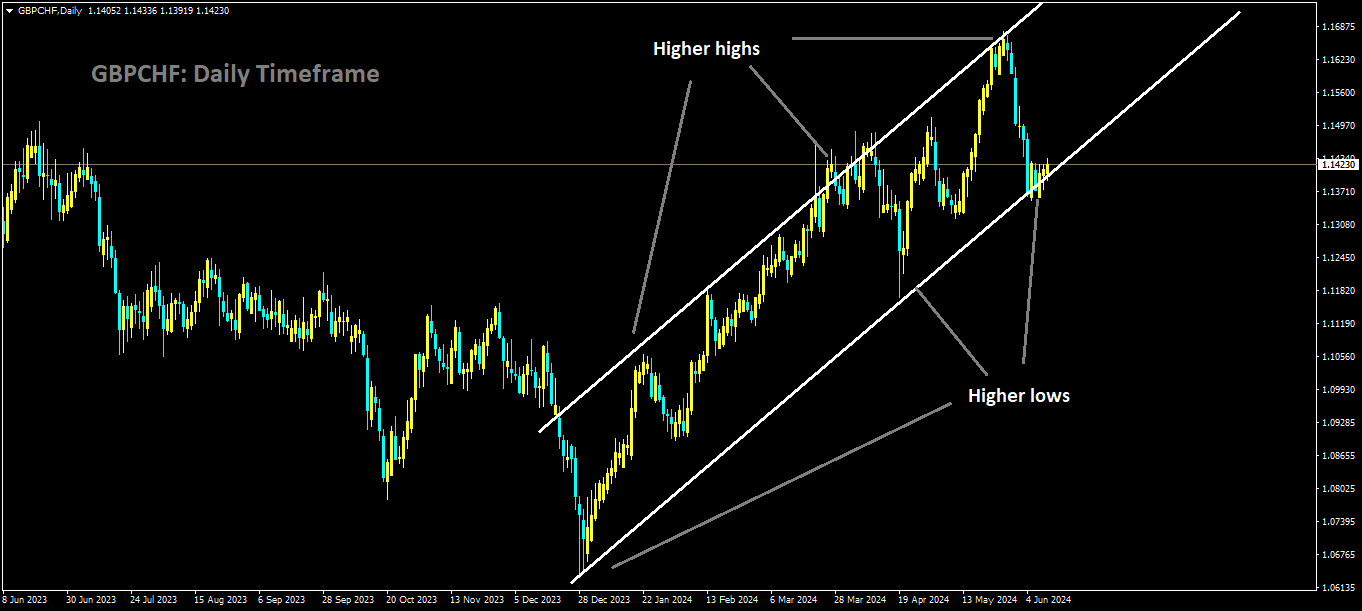GBP: Pound Sterling Rebounds as Steady UK Wage Growth Reduces BoE Rate-Cut Expectations
The UK Unemployment rate came at 4.4% in the April month versus 4.3% printed in the March month, 140K Job losses printed in the April month versus 177K Joblosses printed in the First Q1 2024. Wage growth increased to 6.0% excluding Bonuses and including bonus 5.9% exceeded 5.7% expected rate. BoE hamper the rate cuts due to wage inflation increased to higher rate. GBP down after the reading came in decline side.

GBPUSD is moving in Ascending channel and market has reached higher low area of the channel
The Pound Sterling (GBP) has recovered to 1.2740 during Tuesday’s London session, reversing its earlier losses despite the release of disappointing UK employment data and a firm US Dollar (USD) driven by expectations of delayed interest-rate cuts by the Federal Reserve (Fed).
The UK Office for National Statistics (ONS) reported that the labor market faced its fourth consecutive decline, with employment falling by 140,000 workers in the three months leading up to April. This was less than the 177,000 decline observed in the January-March period. Additionally, the ILO Unemployment Rate increased to 4.4%, higher than the anticipated 4.3% and marking the highest level in over two years. This data suggests that businesses are struggling under the pressure of the Bank of England’s (BoE) higher interest rates.
Despite the weak labor demand, the impact on the BoE’s monetary policy has been mitigated by steady wage growth during the February-April period. Average Earnings Excluding Bonuses, a measure of wage inflation, grew in line with estimates and previous releases at 6.0%. Average Earnings Including Bonuses also saw steady growth, increasing to 5.9%, revised upward from 5.7% and surpassing the 5.7% estimate. Persistent high wage growth could hinder the BoE’s plans to lower interest rates.
The US Dollar is bolstered by cautious market sentiment ahead of the US Consumer Price Index (CPI) data for May and the Federal Reserve’s interest rate decision, both scheduled for Wednesday. The US Dollar Index (DXY), tracking the Greenback against six major currencies, approaches a monthly high near 105.40.

Inflation and Fed Expectations
Monthly Headline Inflation: Expected to grow at a slower pace of 0.1% from 0.3% in April, with annual figures maintaining a steady growth of 3.4%.
Core CPI (Excluding Food and Energy): Expected to decelerate to 3.5% year-over-year from the previous release of 3.6%, with monthly figures holding steady at 0.3%.
Steady or higher-than-expected inflation figures could prompt Fed policymakers to maintain the current interest rate framework for a longer period. Conversely, softer inflation data would reinforce confidence in the progress of the disinflation process.
Key Upcoming Events
Fed’s Interest Rate Decision: Investors are focused on whether the Fed will keep rates on hold for the seventh consecutive time. Policymakers have indicated that they will not lower rates until there is sufficient evidence of inflation sustainably returning to the 2% target.
Fed Chair Jerome Powell’s Press Conference and the Dot Plot: These will provide significant insights into the Fed’s interest rate outlook.
Market Speculation
Current market speculation suggests only one rate cut by the Fed this year, likely in the November or December meeting. Expectations for a rate cut in the September meeting have diminished significantly, reflecting the robust US employment data and the resulting hawkish outlook on monetary policy.
GBP: Unemployment Rate Hits Highest Level in Over Two Years
Summary of UK Labour Market Data for April 2024
Unemployment Rate:
April 2024: 4.4%
March 2024: 4.3%
Job Losses:
April 2024: 140,000
Q1 2024: 177,000
Wage Growth:
Excluding Bonuses: 6.0% (actual) vs. 5.7% (expected)
Including Bonuses: 5.9% (actual) vs. 5.7% (expected)
Implications of the Data
- Rising Unemployment Rate:
The unemployment rate increased slightly to 4.4% in April from 4.3% in March, marking a consistent rise over the past few months.
This suggests a weakening in the labour market, although the increase is modest.
- Job Losses:
There were 140,000 job losses in April, which is a reduction from the 177,000 job losses in the first quarter of 2024. This indicates a slowing pace of job losses, but the overall trend still points to a cooling labour market.
- Wage Growth:
Wage growth remained strong, with earnings excluding bonuses rising by 6.0% year-over-year, surpassing expectations of 5.7%.
Including bonuses, wage growth was 5.9%, again exceeding the expected 5.7%.
- Impact on Bank of England Policy:
The higher-than-expected wage growth is a concern for the Bank of England (BoE) as it suggests persistent inflationary pressures.
Despite the weakening labour market, the strong wage growth could deter the BoE from cutting interest rates in the near term, as it aims to curb inflation.
This wage inflation complicates the BoE’s policy decisions, balancing between supporting the economy and controlling inflation.

GBPCAD is moving in Ascending channel and market has rebounded from the higher low area of the channel.
- Market Reaction:
The British Pound (GBP) declined following the release of this data, reflecting concerns about the weakening labour market and the potential for continued high-interest rates due to inflationary pressures from wage growth.
Conclusion
The latest UK labour market data presents a mixed picture. While the unemployment rate and job losses indicate a cooling labour market, strong wage growth continues to pose an inflationary risk. This dynamic is likely to influence the Bank of England’s monetary policy decisions, making rate cuts less probable in the immediate future despite signs of economic softening. The GBP’s decline reflects market concerns over these mixed signals and the potential for prolonged high-interest rates.
Key Highlights from the Latest UK Employment Data
- Unemployment Rate:
The unemployment rate rose to 4.4% in the three months to April, marking the highest level since September 2021. This is an unexpected rise and the highest in two and a half years.
- Wage Growth:
Despite rising unemployment, wage growth remained strong. Regular earnings, excluding bonuses, increased at an annual pace of 6%, unchanged from the previous month.
When adjusted for inflation, pay increased at an annual pace of 2.9%, the highest since August 2021.
The increase in the National Living Wage to £11.44 an hour in April, up 9.8% from last year, contributed to the expected uptick in pay.
- Economic Inactivity:
The economic inactivity rate increased to its highest level in nearly a decade, with 22.3% of working-age adults (over nine million people) not actively seeking work. This is the highest rate since 2015.
The rise in long-term sickness since 2022 has been a significant factor in the increased inactivity rate.
- Vacancies and Employment:
The number of job vacancies fell by 9,000 to 904,000, indicating a cooling labor market.
Employers’ payrolls showed a drop of 36,000 employees between March and April, with continued declines in May.

- Labor Market Outlook:
The data suggests signs of a cooling labor market, with rising unemployment and falling vacancies, despite strong wage growth.
Worker shortages and high economic inactivity remain persistent issues.
Economic and Policy Implications
- Bank of England (BoE) Response:
The mixed data may not significantly alter the BoE’s immediate policy decisions. KPMG’s chief economist, Yael Selfin, suggested that the BoE would likely keep rates unchanged this month.
Further evidence of cooling in the labor market and progress on inflation could influence the BoE’s timing for an interest rate cut, with some predicting the first rate cut in August.
- Government and Political Reactions:
Work and Pensions Secretary Mel Stride highlighted that the unemployment rate increase was slight and maintained that employment levels are historically strong.
Opposition parties criticized the government’s handling of the economy, citing rising unemployment and decaying public services as indicators of broader economic mismanagement.
Summary
The latest UK employment data presents a complex picture with rising unemployment and high economic inactivity, suggesting a cooling labor market. However, wage growth remains strong, partly due to the recent increase in the National Living Wage. The Bank of England is expected to closely monitor these developments as it considers its monetary policy stance, with potential interest rate cuts on the horizon depending on further inflation data and labor market trends.
GBP: UK Unemployment Rises by 138,000 as Labour Market Weakens
UK Labour Market Data – April 2024
Key Statistics
Unemployment Rate:
April 2024: 4.4%
March 2024: 4.3%
Job Losses:
April 2024: 140,000
Q1 2024: 177,000
Wage Growth:
Excluding Bonuses: 6.0% (Actual) vs. 5.7% (Expected)
Including Bonuses: 5.9% (Actual) vs. 5.7% (Expected)
Analysis
- Rising Unemployment Rate:
The unemployment rate increased to 4.4% in April from 4.3% in March, marking the highest level since September 2021. This is the fourth consecutive increase, indicating a cooling labour market.
- Job Losses:
Job losses decreased to 140,000 in April, down from 177,000 in the first quarter of 2024. Although the pace of job losses has slowed, the trend still points to a weakening job market.
- Wage Growth:
Wage growth remains robust, with earnings excluding bonuses rising by 6.0% year-over-year, exceeding the expected 5.7%. Including bonuses, wage growth was 5.9%, also above expectations.
- Impact on Bank of England Policy:
The stronger-than-expected wage growth suggests persistent inflationary pressures. This complicates the Bank of England’s (BoE) decision-making, as it balances between supporting the economy and controlling inflation.
Despite the weakening labour market, the high wage growth may deter the BoE from cutting interest rates in the near term.
- Market Reaction:
The British Pound (GBP) declined following the data release, reflecting concerns over the weakening labour market and the potential for sustained high-interest rates due to ongoing wage inflation.
Conclusion
The latest UK labour market data presents a mixed picture. The increase in the unemployment rate and job losses points to a cooling labour market. However, strong wage growth continues to pose an inflationary risk, complicating the Bank of England’s monetary policy decisions. The GBP’s decline underscores market apprehensions about the potential for prolonged high-interest rates amidst these mixed signals.
Key Points from the Latest UK Labour Market Data
- Unemployment Increase
The number of unemployed people in the UK rose by 138,000 in the three months to April, reflecting growing signs of a weaker jobs market.
The unemployment rate increased from 4.3% to 4.4%, marking the fourth consecutive rise and reaching the highest level since September 2021.
- Labour Market Trends:
Employment and job vacancies have declined, indicating a cooling labour market.
The number of job vacancies continued to fall, with unfilled posts dropping by 12,000 to 904,000 in the three months to May.
- Economic Inactivity:
Long-term ill-health has led to an increase in economic inactivity, with 55,000 more people not working, bringing the total to a record 2.83 million.

GBPCHF is moving in Ascending channel and market has reached higher low area of the channel
- Wage Growth:
Despite a near 10% increase in the national minimum wage, there are signs that pay growth may have peaked.
Annual growth in average earnings for all workers remained at 5.9%, while for the private sector, it eased from 6.1% to 5.8%.
In April, overall earnings were 5.5% higher than the previous year, down from 6.4% in March. The private sector saw a decrease from 6.8% in March to 5% in April.
5.Real Wage Growth:
Pay in real terms is increasing as wages rise faster than the annual inflation rate, which stood at 2.3% in April.
- Economic and Policy Implications:
KPMG UK’s chief economist, Yael Selfin, noted the rising unemployment rate and attributed the weakening demand for staff to a lack of roles and firms delaying hiring decisions.

The Bank of England (BoE) is unlikely to change interest rates immediately based on this mixed data. Further evidence of labour market cooling and inflation trends will be crucial in their decision-making process.
Stephen Evans, the chief executive at the Learning and Work Institute, emphasized the need for broader employment support, noting that a significant number of people are out of work but want jobs.
Liz Kendall, the shadow work and pensions secretary, criticized the current government’s track record and outlined Labour’s plans to improve employment support and economic stability.
Summary
The UK labour market is showing signs of cooling, with rising unemployment and declining job vacancies, although wage growth remains strong. Economic inactivity due to long-term ill-health has reached a record high. While real wages are increasing due to lower inflation, the broader economic outlook remains uncertain. The Bank of England is likely to maintain its current interest rate stance in the short term, awaiting more definitive trends in labour market data and inflation. Political leaders are reacting to these developments with calls for improved employment support and economic policies.
🔥Stop trying to catch all movements in the market, trade only at the best confirmation trade setups
🎁 60% OFFER for Trading Signals 😍 GOING TO END – Get now: https://forexfib.com/offer/




